- Submissions

Full Text
Cohesive Journal of Microbiology & Infectious Disease
Comparison of Nigeria and Afghanistan in Terms of Diarrheal Disease
İlker Etikan*
Department of Biostatistics, Near East University, Cyprus
*Corresponding author:İlker Etikan, Near East University, Faculty of Medicine, Department of Biostatistics, Nicosia-TRNC, Cyprus
Submission: May 27, 2019; Published: September 03, 2019

ISSN 2578-0190 Volume3 issues1
Abstract
Mortality rate is a very common term when it comes to discussing developing countries, because the rate of mortality which is also known as death rate is very high. Now this mortality rate is influenced by numerous factors, some of which are socio-economic or health related. It focuses on the health related issues that influence, high mortality rate in developing countries. Africa and Asia have a huge amount of the world’s developing countries, Due to the poor socioeconomic, infrastructural and life expectancy standards. It discusses a country from each continent, Nigeria and Afghanistan, their mortality rate due to health related issues. Focusing on diarrhea among infants in this countries.
Keywords: Mortality rate; Africa, health; Developing countries
Introduction
A developing country is a country that has low or middle income when compared to developed countries, it has low industrial and human development index. The term developing can be used to define the present state of a nation, this is a factor that can be changed. Most developing countries in the world have common characteristics like high poverty rate, low literacy levels, government corruption, bad infrastructural facilities and poor health care which can be caused by pollution, spread of infectious diseases, poor hygiene and sanitation. A lot of developing countries have high risk factors in causation of death, this is caused by so many lacking factors, developed countries do not face as much problems because they can be easily curtailed. Asia is the largest and most populous continent in the world with 4.463 billion population, and Africa is the second largest continent in the world. Asia has a good diversity of both developed and developing countries. Afghanistan is located in South Asia which consist of majority developing countries therefore there is a high mortality rate. There are a lot of diseases that cause infant deaths in this countries, the aim is to analyze and evaluate this deaths, and implement all possible means to curtail this deaths.
Child mortality rate and life expectancy
Mortality can be seen as the ultimate endpoint for studies pertaining to life, health and wellbeing. Mortality rate is the measure of the number of deaths with a particular cause in a population, it could be the percent of death per period or per 1000, per year. Life expectancy can be used to define the survival and mortality rates and experiences of different groups of people. Life expectancy is a statistical or mathematical measure of the time an organism lives, based on factors like its birth year, age, gender, health status and so on. Life expectancy can also be considered as the median age at death for a population that is to say that if the Le is 80 years, half of the population died before 80 years and the other half should have died after 80 years. A lot of factors influence life expectancy and LE can be measured at different age groups. LE differs in various countries, developed countries have a high LE meanwhile developing countries have lower LE like in Africa and south Asia because of low economic development and high mortality rate. Developing countries have a good number of older population, but what affects their LE is the high rate of infant mortality due to infections and malnutrition therefore lowering the average LE.
Child mortality is vast, there are different stages in which apparent child mortality occurs like neonatal mortality, infant mortality under five mortality which will be further discussed. Under 5 and infant child mortality rates are the leading indicators of child health status and help in the countries development. Globally there has been a large decline in overall child mortality since the 21st century or the age of enlightenment. In developed countries, child mortality has seen a great percentage decline, it is now lower than 1% and global child mortality has fallen from 18.2% in 1960 to 4.3% in 2015. There has been a huge improvement in this child mortality even in developing countries because of the great incline in global health since the 1900s.
Under 5 mortality
Under 5 mortality rate is the probability of one newborn dyeing before the age of 5 per 1000 live births and infant mortality. As long as they are subject that periods. This rate is the probability of deaths gotten from a life table and expressed in terms of rates per 1000 live births. Under 5 mortality takes up 90% of global mortality rate amongst children under the age of 18 years. More than 60% of these deaths can be avoidable with low cost measures. It is important to disaggregate that is geographically separated in order to identify vulnerable populations. It is the key indicator of child wellness and nutrition status.
Infant mortality
Infant mortality is the deaths of children below the age of 1, this can be measured by the infant mortality rate which can be defined as the probability of a child born in a period dying before the age of 1 per 100 live births. Developing countries take 99% of infant deaths and such deaths occur as a result of premature births, complications in delivery, birth injuries, birth defects, perinatal asphyxia, and low birth weight. This causes are affected by socio economic, psychological and environmental factors which can be eradicated, a reason why infant death risks are more prominent in developing countries.
Neonatal mortality
Neonatal mortality rate can be defined as the probability of a newborn dying within the first 28 days of life at a period per 1000 live births. The neonatal period is the time of a child’s life where they face the most vulnerability 2.5 million children died in their first month of living globally as of year 2017. Neonatal deaths occur at an average rate of 8 per 1000 livebirths. There has been slower progress in curtailing neonatal deaths compared to infant deaths and under 5 deaths.
Child death rates in developing countries Nigeria and Afghanistan
Developing countries have the greater risks of child deaths because of their poor socio economic, bad healthcare, high illiteracy and the number factors that make children susceptible to higher death rates major diseases that cause death of children in developing countries are pneumonia( 19%), diarrhea(18%), malaria (8%), measles (4%), hiv/aids (3%), neonatal conditions (37%). Africa and south Asia has a great number of the worlds developing countries, most of this countries face similar problems. one of which focuses on the risks children face at various stages, as opposed to a developed country which has a way of controlling most of this problems.
Nigeria
Nigeria is the most populous country and one of the largest in Africa. It is located in the western part of Africa, it has a population of about 180 million people, Nigeria suffers a lot of socio economic and developmental issues, that makes its citizen susceptible to a lot of risk. Nigeria has a life expectancy of 54.46 years, and a death rate of 11.94 per 1000 for the year 2018. The birth rate in Nigeria as of 2018 was 36.84 births per 1000. Nigeria has a fraction of the highest child mortality rates in the world due to a lot of factors a lot of which are health factors. It has an infant mortality rate of 66.12 per 1000.
Afghanistan
Afghanistan is a landlocked country bordered by Pakistan and iran, it is located in south central asia, it has a population of 35 million people. Afghanistan has a death rate of 13.4 per 1000, this is influenced by many factors that most developing countries face like health care problems and for the fact that it is a war torn country, lack of health care is also a cause and it is worse in rural areas. It has a birth rate of 37.9 births per 1000, Afghanistan is the third country in the world with the highest child death rate. It has an under 5 mortality rate of 257 per 1000.
Diarrhea
Diarrhea is a preventable disease but still happens to be one of the leading cause of death in children. It is the second leading cause of death in children that are under five years of age, there are about 1.7 billion cases of diarrhea worldwide every year and reportedly 525,000 deaths in a year. Diarrhea is a persistent watery, loose stools that occur three or more times a day, it is characterized by uncontrollable bowel movements. Diarrhea results in dehydration, with this the body is deficit of its essential fluids and salts through the loose stools and it also causes malnutrition or malabsorption that is if enough nutrients are not gotten from foods eaten then they can be lost easily through diarrhea and therefore leaving the body malnourished of nutrients other symptoms could be nausea, abdominal pains, diarrhea caused by infections could result in fever, vomiting, bloody stools and others.
There are three type of diarrhea:
A. Acute diarrhea: caused by infections like viral gastroenteritis, travelers’ diarrhea and medicines, it lasts for a short period about 1 or 2 days.
B. Persistent diarrhea: It can last for long but not too long, the duration of 2 to 4 weeks.
C. Chronic diarrhea: it las for a long time, more than four weeks, it can be caused by infections, food intolerance.
D. Diarrhea is caused by number viral, bacterial and parasitic infections. Some causes are viruses like norovirus and rotavirus.
Bacterial infections like Escherichia coli (E.coli), salmonella, shigella, campylobacter and parasites like cryptosporidium enteritis, Entamoeba histolytica, Giardia lamblia. Viruses like rotavirus are the common causes of diarrhea in children, parasite are rarely a cause and bacteria is also a cause. Diarrhea in kids is more prevalent in developing countries because of lack of good health care, clean water, hygiene. Diarrhea is very preventable but because of most of the factors affecting healthcare as discussed earlier, it is a big challenge in developing countries because a large number of kids are infected and still die daily because of the state of this countries.
Methods
Obtaining facts about the prevalence of diarrhea among children in developing countries, the study of the mortality rate of children with diarrhea at 3 age stages, in Nigeria and Afghanistan. The study of this mortality rate ranges from 2000 to 2016, a period of 17 years. This data is gotten from the UNICEF estimates of child causes of death, diarrhea special 2018. This data as further analyzed and studied using IBM SPSS 25. This data has been analyzed in different stages using both the students T- test and mann whitney test, we analyzed 2 groups Nigeria and Afghanistan for three dependents, neonatal diarrheal death rate (per 1000 live birth)s, infant diarrheal death rate per (1000 live births), under five diarrheal death rate (per 1000 live births) (Figure 1-10).
Figure 1:

Figure 2:
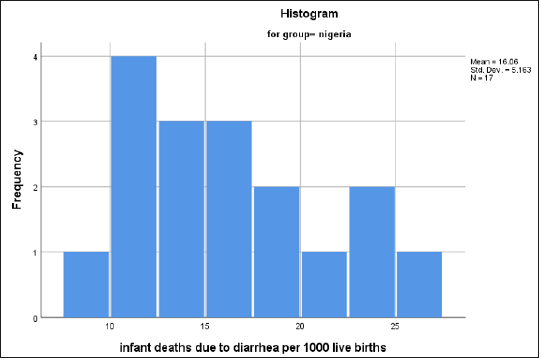
Figure 3:

Figure 4:

Figure 5:
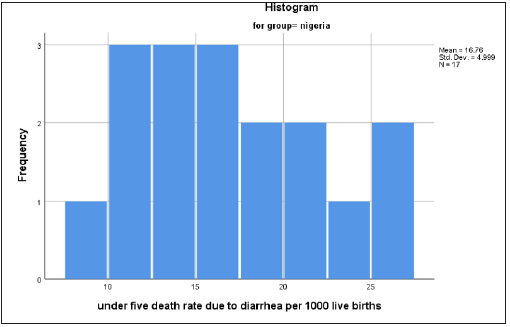
Figure 6:
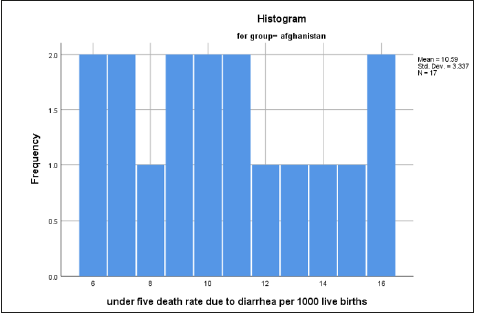
Figure 7:

Figure 8:
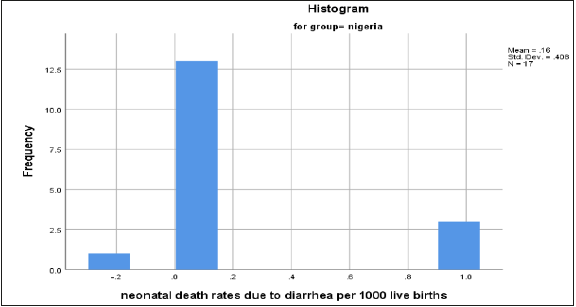
Figure 9:

Figure 10:
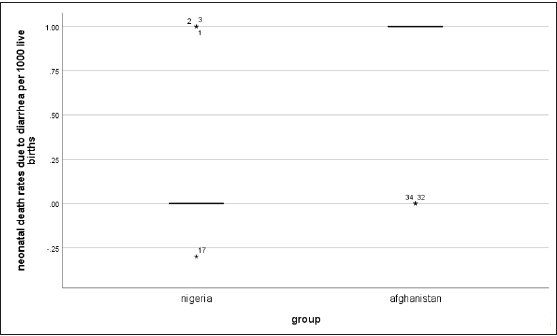
Conclusion
In carrying out this analysis, the parametric student’s t-test was used to analyze infant death rate per 1000 live births and under 5 death rate per 1000 live births in the two groups Nigeria and Afghanistan, while the non-parametric mann -Whitney test was used to analyze neonatal death rate per 1000 live births in Nigeria and Afghanistan. The t-test compares the means of the death rates in the two groups Nigeria and Afghanistan and tells if their statistically significant or not. And the mann- whitney test compares the medians of the neonatal mortality rate of the two groups and their significance [1-12].
A. For infants with diarrheas death rate per 1000 live births, the t test shows a p value of p=0.000 which is p<0.05 which shows that there is a statistical significant difference in infants death rate between Nigeria and Afghanistan. Nigeria has a mean of (μ=16.05, σ= 5.163, ±1.252) and Afghanistan has a mean of (μ=10.18, σ=3.206, ±0.778) which shows that Nigeria has a larger number of infant mortality rate collectively over the years. From the standard deviations, Afghanistan’s death rate values have been a bit more consistent over the years. Nigeria has larger shifts in the mortality rate values over the years (Table 1-4).
Table 1:Child mortality rate of Nigeria from 2008-2017, per 1000 live births.
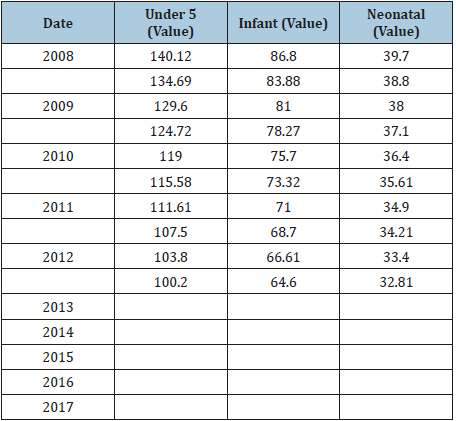
Table 2:Child mortality rate of Afghanistan from 2008- 2017, per 1000 live births.
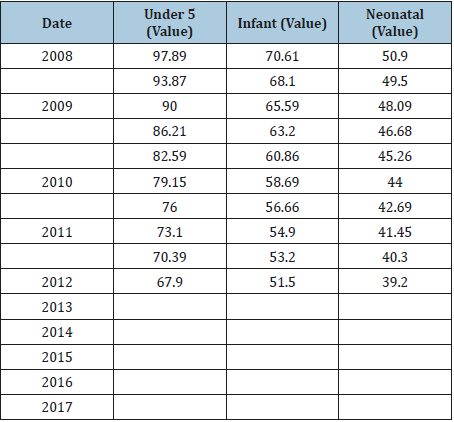
Table 3:Group statistics.
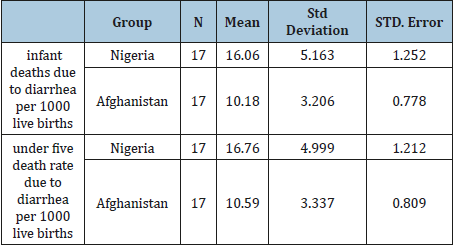
Table 4:Ranks.

B. Under five children with diarrheas death rate is quite similar with that of infants in both countries. A t test was also done for this and it shows a p value of p=0.000 meaning p<0.05 showing that there is a statistically significant difference in the means of under-five children’s death rate between Nigeria and Afghanistan over the year. Nigeria has a mean of (μ=16.76, σ= 4.999, ±1.212) and Afghanistan (μ=10.59, σ=3.337, ±0.809) this shows that Nigeria has a larger average under five death rate than Afghanistan.
C. For neonatal with diarrhea death rate per 1000 live births, it is a lot different from the other conditions. The nonparametric mann- whitney test was used and we have a p value of p=0.00 and p<0.05 this shows that there’s a statistically significant difference in the neonatal death rate between both countries. Nigeria has a median=0.00, min=0, max=1 and Afghanistan has median=1.00, min=0, max=1. This results shows that both countries have very low number of deaths per year when it comes to neonatal dying of diarrhea. This shows that diarrhea might not be one of the highest leading causes of death in newborns.
References
- You, D, Jones, G, Hill K, Wardlaw T, Chopra M (2010) Levels and trends in child mortality, 1990-2009. The Lancet 376(9745): 931-933.
- Ramazzotti A (2013) Developing countries. Nova Science Publishers. Inc, New York, USA.
- Oloo J (2005) Child mortality in developing countries: Challenges and Policy Options. Eastern Africa Social Science Research Review 21(2): 1-17.
- Missov T (2013) Gamma-Gompertz life expectancy at birth. Demographic Research 28(9): 259-270.
- Khanna R, Lakhanpaul M, Burman-Roy S, Murphy M (2009) Diarrhoea and vomiting caused by gastroenteritis in children under 5 years: summary of NICE guidance. BMJ 338: b1350-b1350.
- Du Pont H (1985) Diarrheal diseases: An overview. The American Journal of Medicine 78(6): 63-64.
- Cohen J (2011) Life expectancy. Demographic Research 24: 251-256.
- Chronic Diarrhea in Children (2014) National Institute of Diabetes and Digestive and Kidney Diseases (NIH), 14(14-7714).
- https://data.unicef.org/topic/child-survival/under-five-mortality/
- Carvajal-Vélez, L, Amouzou, A, Perin, J, Maïga, A, Tarekegn, H, et al. (2016) Diarrhea management in children under five in sub-Saharan Africa: does the source of care matter? A Countdown analysis. BMC Public Health 16(1).
- Alkema L, New J, Pedersen J, You D (2014) Child Mortality Estimation 2013: An Overview of Updates in Estimation Methods by the United Nations Inter-Agency Group for Child Mortality Estimation. PLoS ONE 9(7): p.e101112.
- Alebel, A, Tesema, C, Temesgen, B, Gebrie, A, Petrucka, P, et al. (2018) Prevalence and determinants of diarrhea among under-five children in Ethiopia: A systematic review and meta-analysis. PLOS ONE 13(6): p.e0199684.
© 2019 İlker Etikan. This is an open access article distributed under the terms of the Creative Commons Attribution License , which permits unrestricted use, distribution, and build upon your work non-commercially.
 a Creative Commons Attribution 4.0 International License. Based on a work at www.crimsonpublishers.com.
Best viewed in
a Creative Commons Attribution 4.0 International License. Based on a work at www.crimsonpublishers.com.
Best viewed in 







.jpg)






























 Editorial Board Registrations
Editorial Board Registrations Submit your Article
Submit your Article Refer a Friend
Refer a Friend Advertise With Us
Advertise With Us
.jpg)






.jpg)














.bmp)
.jpg)
.png)
.jpg)










.jpg)






.png)

.png)



.png)






